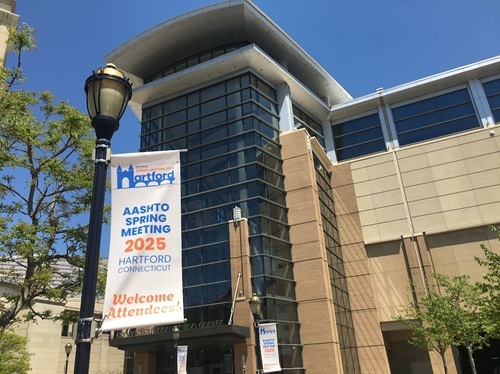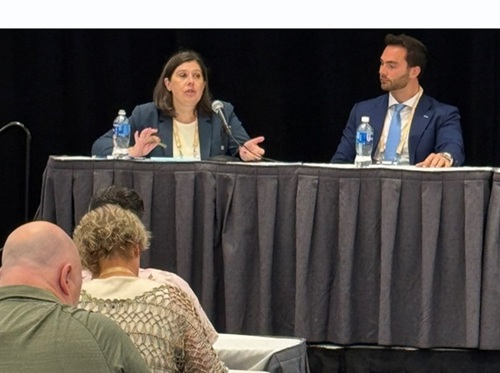Susan Howard (above at left), policy and government relations director for the American Association of State Highway and Transportation Officials, recently spoke at the National Conference of State Legislatures’ 2025 Legislative Summit in Boston to offer insights into the ongoing surface transportation funding reauthorization process in Congress.
[Above photo by AASHTO]
She explained that, every five years, Congress reauthorizes surface transportation funding that covers everything from interstate highways and bridges to trails, transit systems, traffic safety initiatives, research and development endeavors, plus much more.
The current reauthorization measure –the Infrastructure Investment and Jobs Act or IIJA – expires in September 2026.

As a result, AASHTO began developing in February 2024 a set of policy recommendations to Congress for the new bill to succeed the IIJA – with AASHTO’s board of directors unanimously adopting three core policy principles regarding surface transportation reauthorization in April and six policy resolutions at the organization’s 2025 Spring Meeting in Hartford, CT, this May.
Howard noted that while the IIJA brought about a “substantial increase” in federal investment in surface transportation, inflationary costs significantly eroded much of the economic benefit of that additional funding. That is why she said AASHTO believes overall funding levels in the IIJA should be the “baseline” of federal surface transportation funding moving forward; growing steadily year to year over the life of the next bill so states keep up with ever-growing transportation needs.
She said AASHTO and its member departments believe that, in the next authorization bill, Congress should increase the extent to which formula funding is prioritized over discretionary funding – ensuring that 95 percent or more of authorized Highway Trust Fund highway dollars go to apportioned programs for states.
“Formula dollars provide stability, predictability, and efficiency, allowing state and local governments to plan and deliver projects effectively,” she said. “If there is a desire to address additional priorities, the most efficient way to meet those priorities is through expanded eligibility within existing formula programs.”
Other state DOT policy priorities Howard touched on in her remarks include:
- Use discretionary grants only for projects of utmost federal interest;
- Support states that want to assume more federal responsibilities and the associated accountability, especially when it comes to National Environmental Policy Act or NEPA agreements;
- Fully implement the One Federal Decision process to speed up the review timeline for projects and improve the accountability for all parties involved in a project’s development;
- Create a more safe, resilient, and efficient future by supporting the ability of state DOTs to harness innovation by speeding up technology procurement and transfer programs; and
- Establish a standardized “governance framework” for infrastructure and vehicle connectivity.
“These are just some of the key reauthorization items that will support and strengthen the nation’s transportation infrastructure with improved safety and mobility for all,” Howard noted.
 Top Stories
Top Stories
Modal Administrators Speak at AASHTO Annual Meeting
December 5, 2025 Top Stories
Top Stories

